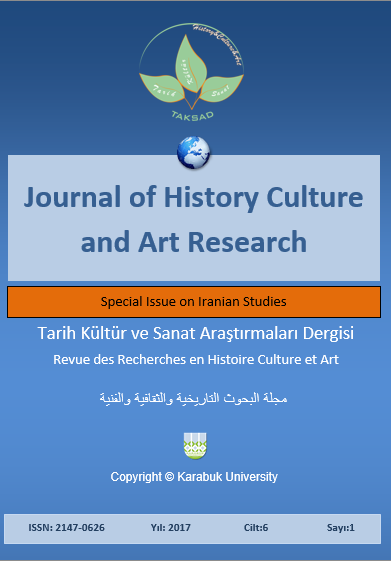Comparative Comparison of City and Urbanism during Sassanid Period in Iran and the Ancient Roman
DOI:
https://doi.org/10.7596/taksad.v6i1.771Keywords:
City, Urbanization, Sassanid, The Ancient Roman, Hippodomus.Abstract
Sassanid replaced migrating nomads and tribes with urbanization system and concentration of population. Sassanid desire to increase the population was due to the fact that population is the core of urban systems and focus-oriented system. Sassanid tried marching to Syria and Asia Minor to gain population. Immigrant Roman population was accommodated in newly established cities. Romans had structured and deep thinking about urban development, such that their territory was made up of urban units which were connected through a system of roads and bridges. Romans innovation in urban development can be summed up in creating military cities. Sassanid urbanization after the Parthians was influenced by Roman urbanization which is most visible in the shape of Sassanid cities. In this study, while examining cities and urbanization in Sassanid reign and Roman Empire, their influence on each other and their similarities and differences in their urbanization methods were also investigated.
References
Aboueye Mehrizi, Nadia (1392). "Architecture in Iran from the beginning to the end of the Sassanid era". Research in the Humanities. Fourth year. No. 19.:63-90. (Iranian Calendar).
Abu Hanifa Dinwari, Ahmad ibn Dawood (1364). Al-Akhbār Al-towāl. translated by Mahmoud Mahdavi Damghani. Tehran: Ney. (Iranian Calendar).
Ali Akbari, Ismaeil (1383). "An Approach to Restore the Old Values in Contemporary Urbanism". Peyk Noor. no. 2.:47-62. (Iranian Calendar).
Barbadoro, Bernardin (1381). Twenty-Seven Centuries of History of Italy and Europe. Translated by Hassan Afzali Nezhad. Tehran: Hall of Book. (Iranian Calendar).
Biroch, Paul (1988). Cities and Economic Development: From the Dawn of History. Translated by Christopher Braider. Chicago: the university of Chicago Press.
Daryaee, Touraj (1390). Sassanian Empire. Translated by Morteza Saghebfar, Fifth Publication. Tehran: phoenix. (Iranian Calendar).
Durant, William James (1367). The History of Civilization. vol. III, Parviz Dariush Translation. Tehran: Scientific and Cultural. (Iranian Calendar).
Falamaki, Mansour (1371). Modernization and Urban Sanitation. Tehran: Samt. 1388. (Iranian Calendar).
Farid, Yadollah (n.d.). Geography and Urbanity. Tabriz: Tabriz University. (Iranian Calendar).
Grimal, Pierre (1983). Roman Cities. Translated and Edited by G. Michael Woloch. The University of Wisconsin.
Habibi, Seyyed Mohsen (1383). From Street to City. Tehran: Tehran University. (Iranian Calendar).
Hoff, Dietrich (1374). A Glimpse into the Iranian Capitals since the Beginning of Islam. Translated by Gholam Ali Shamloo. The Capitals of Iran by Mohammad Yousef Kiyani. Tehran: Cultural Heritage Organization. (Iranian Calendar).
Ibn Athir, Ali ibn Mohammad (1349). al-Kāmel. Vol. I. Translated by Seyyed Hassan Rouhani, Tehran: Mythology. (Iranian Calendar).
Khoramshad, Mohammad (1392). "From City to City in The History: An Overview of The History of Urbanism. Soore Andishe, No. 69-68.:30-34. (Iranian Calendar).
Lucas, Henry (1382). History of Civilization Form the Oldest to Our Century. Translated by Abdul Hossein Azarang. Tehran: Sokhan. (Iranian Calendar).
Lynch, Kevin (1381). The Theory of City. Translated by Hossein Bahreyni. Tehran: Iran Cultural Heritage Organization. (Iranian Calendar).
Majmá Al -tawarikh wa Al-Qesas (1318). The correction of Bahar. Tehran: Kolaleh Khavar. (Iranian Calendar).
Malet, Albert (1383). The History of Rome. vol. I. translated by Gholam Hossein Zirakzadeh. Tehran: The World of Books. (Iranian Calendar).
Masoudi, Abul Hasan Ali ibn Hossein (1374). Morouj Al-dhahab wa Maāden Al- johar. Translated by Abolghasem Payandeh. Tehran: Scientific and Cultural. (Iranian Calendar).
Mehrafarin, Reza. (n.d.). Sassanian Cities. First Publication. Tehran: Samt.
Morris, James (1393). The History of City Shape to Industrial Revolution. Translated by Razieh Reza zadeh. University of Science and Technology. 1388. (Iranian Calendar).
Mumford, Lewis (1381). Civility and Civil Society in Historical Context. Translated by Ahmad Azimi Bolourian. Tehran: Aria cultural institution. (Iranian Calendar).
Orian, Saeed (1382). Directory of Middle Persian inscriptions. Tehran: Iran Cultural Heritage Organization. (Iranian Calendar).
Pakzad, Jahanshah (1392). The History of the City and Urbanization in Europe. Tehran: Utopia. (Iranian Calendar).
Soltanzadeh, Hossein (1365). An Introduction to the History of the City and Urbanization in Iran. Tehran: Abi. (Iranian Calendar).
Stanislowski, Dan (1946). "The origin and Spread of the grid- pattern town., Geographical Review. vol. xxxvi. No.1.: 105-120.DOI: 10.2307/211076.
Tabari, Mohammad ibn Jarir (1352). Tarikh Al-Țabari. Vol. II. Translated by Abolghasem Pyandeh. Tehran: Iranian Culture Foundation. (Iranian Calendar).
Thompson Rowell, Henry (1349). Rome at the Age of August. Translated by Abu Talib Sarami. Tehran: Agency of translation and boo publication. (Iranian Calendar).
Vetkin, David (1390). Architectural History of the West. Translated by Mohammad Taghi Faramarzi. Tehran: Kavoosh Pardaz. (Iranian Calender).
Weber, Max (1375). City in The Course of Time. Translated by Shiva Kaviani, Tehran: Sahami Enteshar. (Iranian Calender).
Yousefi far, Shahram (1389). "The Emergence of Cities and Urbanization in the History of Iran". The History of Iran. no. 64/5.:145-170. (Iranian Calender).
Downloads
Published
How to Cite
Issue
Section
License
All papers licensed under Creative Commons 4.0 CC-BY.- Share — copy and redistribute the material in any medium or format
- Adapt — remix, transform, and build upon the material for any purpose, even commercially.
Under the following terms:
Attribution — You must give appropriate credit, provide a link to the license, and indicate if changes were made. You may do so in any reasonable manner, but not in any way that suggests the licensor endorses you or your use.
- No additional restrictions — You may not apply legal terms or technological measures that legally restrict others from doing anything the license permits.







